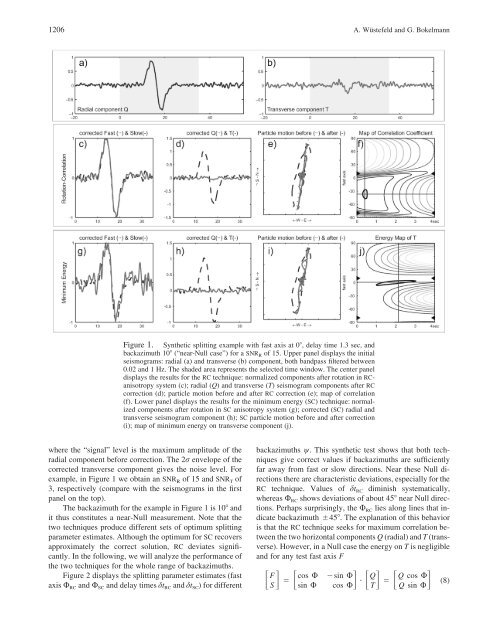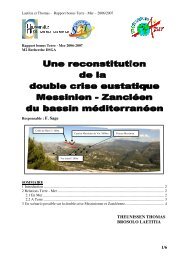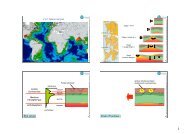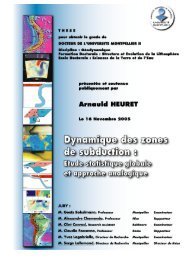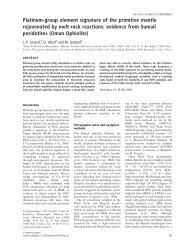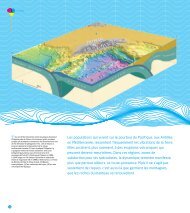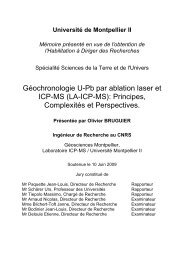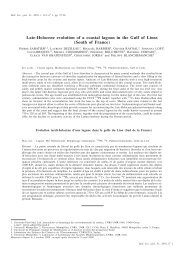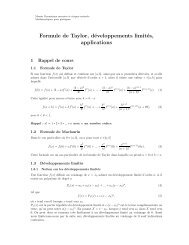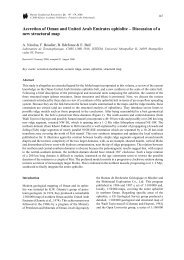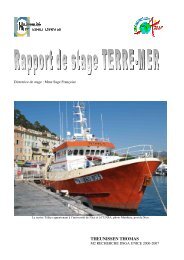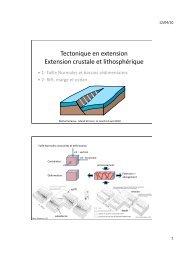Null Detection in Shear-Wave Splitting Measurements
Null Detection in Shear-Wave Splitting Measurements
Null Detection in Shear-Wave Splitting Measurements
Create successful ePaper yourself
Turn your PDF publications into a flip-book with our unique Google optimized e-Paper software.
1206 A. Wüstefeld and G. BokelmannFigure 1. Synthetic splitt<strong>in</strong>g example with fast axis at 0, delay time 1.3 sec, andbackazimuth 10 (“near-<strong>Null</strong> case”) for a SNR R of 15. Upper panel displays the <strong>in</strong>itialseismograms: radial (a) and transverse (b) component, both bandpass filtered between0.02 and 1 Hz. The shaded area represents the selected time w<strong>in</strong>dow. The center paneldisplays the results for the RC technique: normalized components after rotation <strong>in</strong> RCanisotropysystem (c); radial (Q) and transverse (T) seismogram components after RCcorrection (d); particle motion before and after RC correction (e); map of correlation(f). Lower panel displays the results for the m<strong>in</strong>imum energy (SC) technique: normalizedcomponents after rotation <strong>in</strong> SC anisotropy system (g); corrected (SC) radial andtransverse seismogram component (h); SC particle motion before and after correction(i); map of m<strong>in</strong>imum energy on transverse component (j).where the “signal” level is the maximum amplitude of theradial component before correction. The 2r envelope of thecorrected transverse component gives the noise level. Forexample, <strong>in</strong> Figure 1 we obta<strong>in</strong> an SNR R of 15 and SNR T of3, respectively (compare with the seismograms <strong>in</strong> the firstpanel on the top).The backazimuth for the example <strong>in</strong> Figure 1 is 10 andit thus constitutes a near-<strong>Null</strong> measurement. Note that thetwo techniques produce different sets of optimum splitt<strong>in</strong>gparameter estimates. Although the optimum for SC recoversapproximately the correct solution, RC deviates significantly.In the follow<strong>in</strong>g, we will analyze the performance ofthe two techniques for the whole range of backazimuths.Figure 2 displays the splitt<strong>in</strong>g parameter estimates (fastaxis U RC and U SC and delay times dt RC and dt SC ) for differentbackazimuths w. This synthetic test shows that both techniquesgive correct values if backazimuths are sufficientlyfar away from fast or slow directions. Near these <strong>Null</strong> directionsthere are characteristic deviations, especially for theRC technique. Values of dt RC dim<strong>in</strong>ish systematically,whereas U RC shows deviations of about 45 near <strong>Null</strong> directions.Perhaps surpris<strong>in</strong>gly, the U RC lies along l<strong>in</strong>es that <strong>in</strong>dicatebackazimuth 45. The explanation of this behavioris that the RC technique seeks for maximum correlation betweenthe two horizontal components Q (radial) and T (transverse).However, <strong>in</strong> a <strong>Null</strong> case the energy on T is negligibleand for any test fast axis F F cos U s<strong>in</strong> U Q Q cos U • (8)S s<strong>in</strong> U cos U T Q s<strong>in</strong> U


